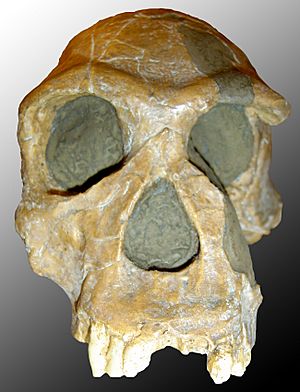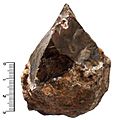Homo habilis facts for kids
Quick facts for kids Homo habilisTemporal range: Pliocene-Pleistocene
|
|
|---|---|
 |
|
| Scientific classification | |
| Kingdom: | |
| Phylum: | |
| Class: | |
| Order: | |
| Family: | |
| Genus: | |
| Species: |
H. habilis
|
| Binomial name | |
| †Homo habilis Leakey et al., 1964
|
|
Homo habilis was an early human ancestor. Scientists call them the "handy man." This is because they were among the first to use simple stone tools. Their remains have been found in places like the Olduvai Gorge in Tanzania. These fossils are about 2 million years old.
Contents
Who Was Homo Habilis?
Homo habilis is an important part of the human story. They lived a very long time ago, during the Pliocene and Pleistocene periods. Finding their fossils helps us understand how early humans developed.
Where They Lived
Most Homo habilis fossils have been found in eastern and southern Africa. The most famous discovery site is the Olduvai Gorge in Tanzania. Other important sites are in Kenya. These areas were likely rich in resources, which helped early humans survive.
What They Looked Like
Homo habilis had some features that were similar to older human ancestors, like the Australopithecus. They had a flat face and large molar teeth. However, their brain was bigger, about 700 cubic centimeters (cc). This was a big step in human brain growth.
Their body shape was a bit "apelike." They had long arms and a smaller body compared to modern humans. They were usually about 1.3 meters (4 feet 3 inches) tall. They weighed around 37 kilograms (82 pounds).
The "Handy Man" and Tools
The name Homo habilis means "handy man." This name was given because scientists found simple stone tools near their fossils. These tools were likely used for cutting meat or breaking open bones. This ability to make and use tools was a big step for early humans. It showed they could think ahead and plan.
Scientific Debates
Scientists still discuss Homo habilis a lot. They don't always agree on its exact features. Some even wonder if it should be a separate species from other early human groups. This is part of how science works: new discoveries can change what we understand.
Related pages
Images for kids
-
Cast of the type specimen OH 7
-
Oldowan chopper
See also
 In Spanish: Homo habilis para niños
In Spanish: Homo habilis para niños






